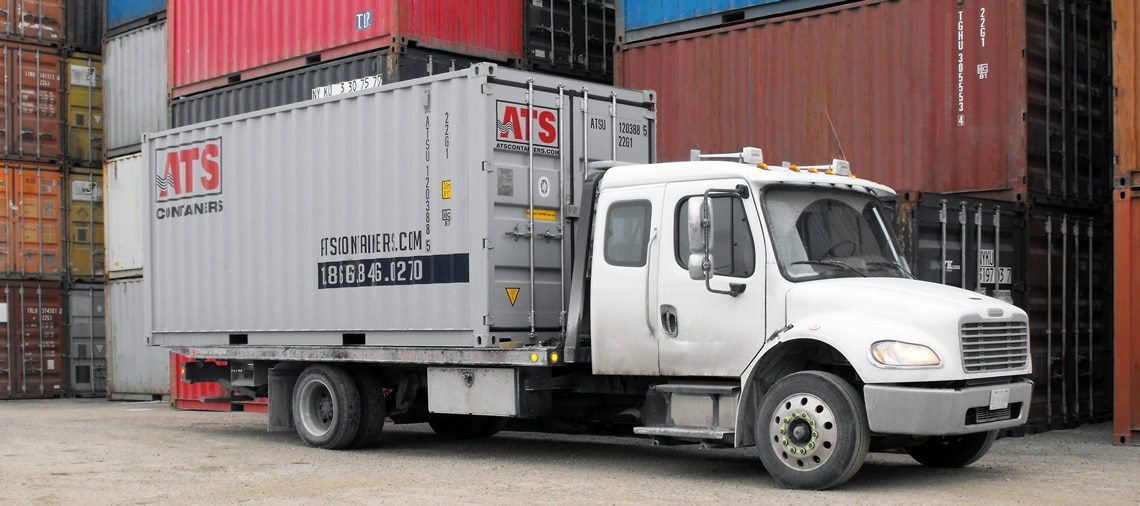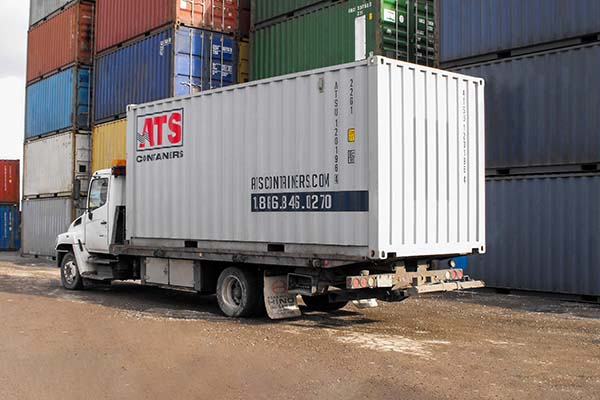
DOOR LOADING DIRECTION
The placement of the original container doors on the truck is very important to consider for its final placement at your location.
Keeping in mind that the truck backs into position to tilt the container onto the ground, loading the truck with the container doors facing the rear will result in the doors being placed in their final position first.
If the container doors are loaded to face the cab of the truck, the doors will be the last part of the container to be placed onto the ground. While the sales team can certainly help explain the process in more detail, it is the customer who better understands the final placement on site and must provide us appropriate door loading directions for delivery.
DOORS TO CAB

DOORS TO REAR

GROUND PREPARATION
Delivery must be on firm ground that is able to support the combined weight of the trailer and container to prevent sinking. A delivery of a container on grass or mud can be problematic as the ground will not be firm enough.
Weather conditions can affect ground conditions during the winter, making it difficult to deliver unassisted with a trailer. Spring thaw can also result in soft ground that could complicate or result in an unsuccessful delivery.
The ground must be firm, dry and level to ensure a successful delivery.
The delivery driver will assess accessibility and ground conditions on site and determine if they can proceed as planned. If there is a risk of the trailer sinking, the driver will not attempt delivery. An unsuccessful delivery will result in additional costs including the delivery and return transport fee. Alternatively, we recommend considering another drop location on site that is better suited to receive the container to avoid these costs.
If delivery is scheduled and ground conditions are not ideal due to rainfall, snowstorms, or other factors, please contact our team to reschedule and ensure a successful delivery.
LEVEL GROUND
One of the most important factors we can recommend is to ensure that the containers doors are sitting on a relatively level ground surface on delivery. This prevents the frame from bending and twisting which can lead to eventual issues opening and closing the doors over time.
We also strongly recommend that the container does not sit directly in grass or surfaces where water can pool to extend the longevity of your sea container. Excess moisture can rot the undercarriage of the container which can affect the structural integrity of the flooring.
We are often asked how to prepare a site to ensure the container is sitting on level ground. Best practices include placing the container on a concrete pad, pavement, crushed gravel bed, railroad ties, wood, etc. to ensure door functionality and maximize life span.

SITE ACCESS
Tilt trailers deliver shipping containers by backing into position and slowly dropping the container into place. Ensuring sufficient space for the trailer to maneuver on site and ample straight-line clearance is critical for a successful delivery.
The site must have sufficient width, height, and length requirements to enter and deliver on the property.
TRANSPORT DIMENSIONS

UNLOADING DIMENSIONS

Considering the container will be positioned on a trailer deck that is 12’W, the driver will require a minimum of 1′ ft on either side, for a minimum width clearance of 14’W. Once the driver has positioned the container, he will tilt the deck upward to reach 18’H at its highest point. This also something to consider for low hanging power lines, tree branches, etc. Finally, straight-line clearance refers to the distance required to drop a container once the driver is in position.
STRAIGHT-LINE CLEARANCE
Once the delivery truck has entered the property, the trailer will require sufficient space in a straight line to delivery into the desired spot. This is known as straight line clearance. This clearance is critical for a successful delivery.

20FT CONTAINER DELIVERY

40FT CONTAINER DELIVERY
For the delivery process to run smoothly, the truck will require a minimum of 65 feet of straight-line clearance to deliver a 20’ shipping container. For the delivery of a 40’ container, the truck will require a minimum of 110 ft of straight-line clearance. This space requirement includes the length of the container itself, the length of the truck deck and finally, the truck itself as shown below.
Machinery required to unload your container from a Flatbed or Step deck trailer

As previously explained, a container delivered on a flatbed or step deck trailer will require machinery on site to unload the container from the deck. The equipment required will depend on the size and weight of the container.
Heavy Duty Forklifts
20’ and 40’ empty containers can be unloaded using an 18,000lbs heavy-duty forklift with a 48” load center and 8’ long forks. Please keep in mind that standard warehouse forklifts typically do not meet these criteria.
Crane or Boom truck
Renting a crane or a boom truck to offload a shipping container from a flatbed or step deck is often the most common machinery used. A crane or boom truck is capable of lifting the container from its corner castings and allowing for more on site flexibility with regards to space constraints and container placement. It can also be more cost effective than renting a heavy-duty forklift.